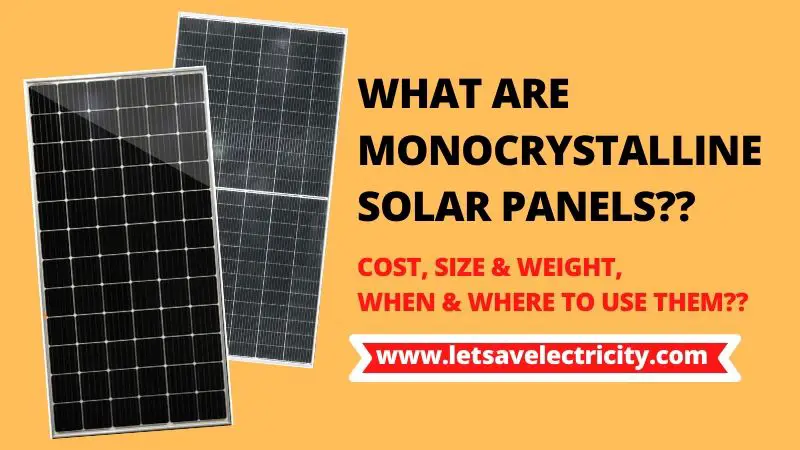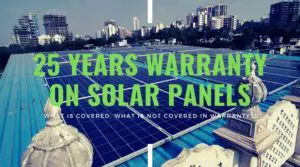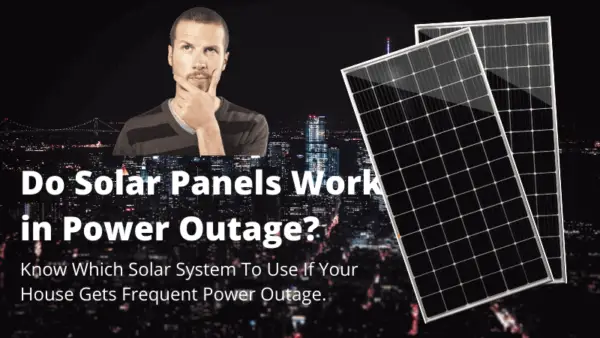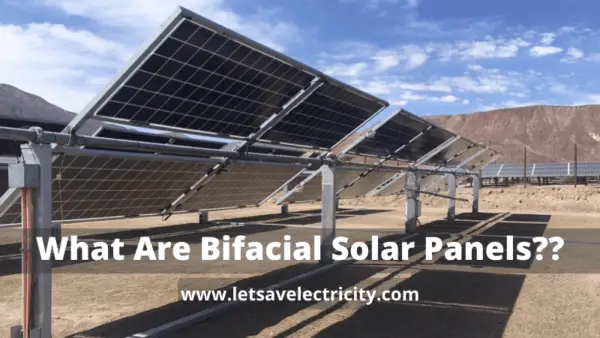What are monocrystalline solar panels? Should I go with monocrystalline solar panels for my solar project or polycrystalline solar panels will be just fine. In this article we will see what are monocrystalline solar panels, how much they cost, when should you use them and all other information related to them.
What are monocrystalline solar panels?
As the name suggests in monocrystalline solar panels, the solar cells are made up of single silicon crystal.
To make solar cells for monocrystalline solar panels, silicon is formed into cylindrical bars called as ‘silicon ingot’. Then the silicon ingot is cut into squares with chamfered edges know as silicon wafers. These silicon wafers are solar cells which are then assembled in rows and columns to form a solar panel.
Monocrystalline solar cell manufacturing process is called ‘Czochralski process’. It is a complex and expensive manufacturing process which results in lot of wastage of silicon crystals, which makes them more expensive than polycrystalline solar panels.
If you want to learn more about solar panels manufacturing process then check out this awesome video.
Difference between mono & poly solar panels:
Unlike monocrystalline solar cells, polycrystalline solar cells are made by melting fragments of different silicon crystals and pouring it in a mold to give solar cells a square shape. Since single pure silicon is not need to manufacture polycrystallline solar cells their manufacturing process is less expensive, hence they are cheaper than monocrystalline solar panels.
Whatever silicon is wasted during manufacturing of monocrystalline solar panels is used to manufacture polycrystalline solar panels.
How does monocrystalline solar panel appear?
If you see a solar panel then by visual inspection it is quiet easy to identify whether it is monocrystalline solar panel or polycrystalline solar panel.
The two main distinguishing factor in monocrystalline solar panels are:
- The surface of the monocrystalline solar panel is black in colour because of the use of pure silicon crystal, whereas polycrystalline solar panels have blue surface.
- In mono, Individual solar cells which make the solar panel are of square shape with chamfered edges, whereas in polycrystalline solar panels they are of square shape without chamfered edges.
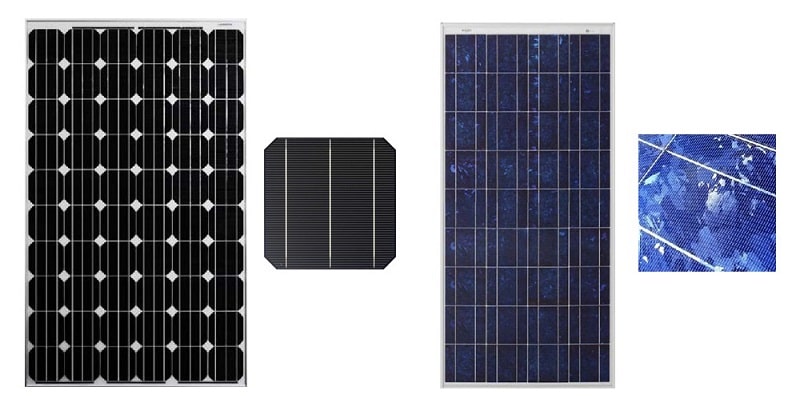
What is the efficiency of monocrystalline solar panels?
Since the cell of monocrystalline solar panels is composed of a single silicon crystal, the electrons that generate flow of electricity have more room to move. As a result, monocrystalline panels are more efficient than their polycrystalline counterparts.
Monocrystalline solar panels have the highest efficiency among polycrystalline and thin film solar panels.
Monocrystalline solar panels have 18 % – 20 % efficiency, which means out of 100% sunlight falling on the solar panel 18% of it is converted in electricity and rest is wasted.
Whereas polycrystalline solar panels have 16 %- 18 % efficiency, and one with PERC technology has almost same efficiency as monocrystalline PV panels of same wattage.
I pulled the data from Canadian solar KuMax series and HiKu series and it is quite evident that the difference in efficiency isn’t much to bother about.
| Canadian Solar | Efficiency Poly (%) | Efficiency Mono (%) |
| KuMax Series (370W) | 18.65 | 19.15 |
| HiKu PERC Series (365W) | 19.73 | 19.73 |
You can check the datasheet from this link – https://canadiansolar.com/solarPanels/detail/29
What is the Price of monocrystalline solar panels?
Since the manufacturing process of extracting pure silicon and using it to make solar panels is very complex and expensive, monocrystalline solar panels are the most expensive of crystalline solar panels available in the market.
On an average in India the prices of monocrystalline solar panels varies between Rs 32 / watt to Rs 50 / watt depending on the brand and cell configuration.
On the other hand polycrystalline solar panels cost anywhere between Rs 20 / watt to Rs 26 / watt.

What is the size of monocrystalline solar panels?
Both mono & polycrystalline solar panels come in various sizes. The size and wattage depends on the number of solar cell and the cell configuration.
Every solar panel be it mono or poly is made by connecting solar cells in series and parallel arrangement, the standard size of a solar cell is 156 mm X 156 mm (approx. 6 inch X 6 inch).
For a 60 cell solar panel the cell arrangement can be 6 X 10 and for a 72 cell solar panel cell arrangement is 6 X 12.
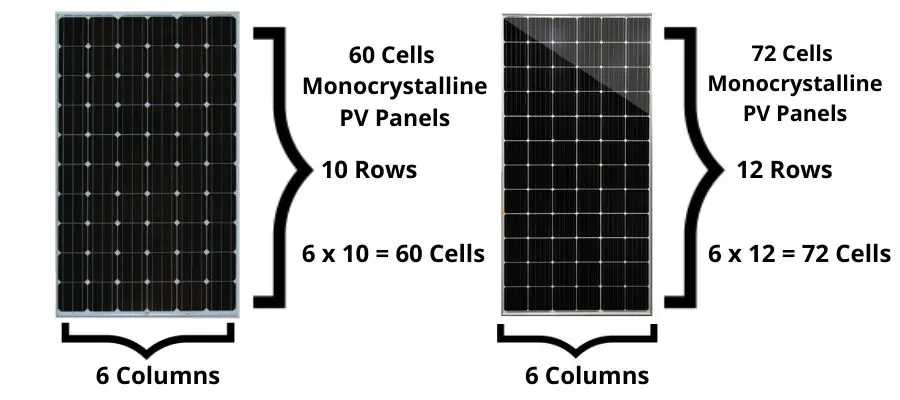
Now a days you will also see half cut 120 cells and half cut 144 cells solar panels too.
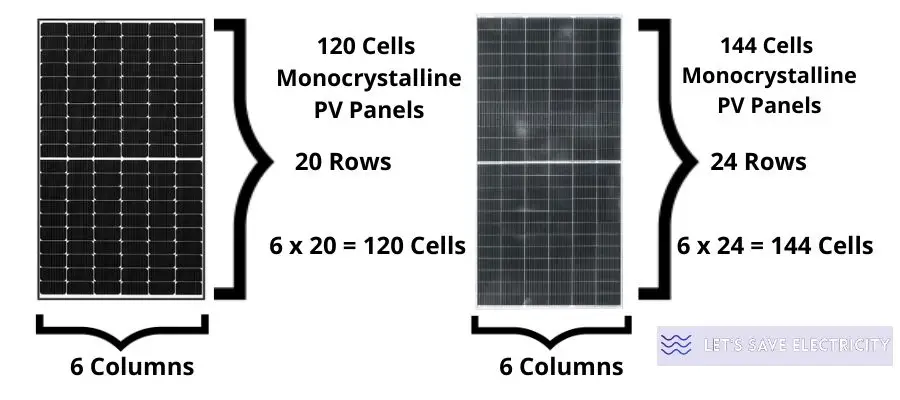
The standard size of a monocrystalline solar panel is:
- The size of a solar panel with 60 cell configuration is 39 inch X 66 inch (3.25 ft X 5.5 ft).
- The size of a solar panel with 72 cell configuration is 39 inch X 77 inch (3.25 ft X 6.42 ft).
The standard weight of a monocrystalline solar panel is:
- The weight of a 60 cell solar panel is 16-22 kg.
- The weight of 72 cell solar panel is 22 – 28 kg.
When to use monocrystalline solar panels:
The main reason for going solar for most customers is the big savings in electricity bill they get. But to get this big savings should you install mono solar panels or poly solar panels will get the job done. Let’s see when to use monocrystalline solar panels.
- Rooftop Area is less: If after calculating your solar requirement you came to know the rooftop area you have will only save 50% of your electricity bill then you should go with monocrystalline solar panels, because they will produce more power in the same area resulting in more savings in electricity bill.
- Low light region: If you live in a place where the intensity of sunlight is less and there is snowfall, then you should go with monocrystalline PV panels as they have better low light performance which will help you generate more power, hence more savings.
Advantages of monocrystalline solar panels:
- Monocrystalline solar panels have the highest efficiency since they are made out of the highest-grade silicon.
- Monocrystalline solar panels are space-efficient. Since these solar panels yield the highest power outputs, they also require the least amount of space compared to any other types. However, monocrystalline solar panels produce marginally more power per square foot of space used as we saw in table before.
- Crystalline PV panels have a long lifespan. Most solar panel manufacturers put a 25-year warranty on their monocrystalline solar panels. Because both types of crystalline solar panels are made from crystalline silicon, a very inert and stable material it is very likely that these solar panels will last much longer than their 25-year warranty life.
- Monocrystalline solar panels tend to be more efficient in warm weather. With all solar cells, electricity production falls as temperature goes up. However, this degradation of output is less severe in monocrystalline panels than polycrystalline solar panels. However, in practice, the difference is very small. The level to which each solar panels production falls as temperature increases is called the temperature coefficient and is published with the specifications for each panel.
- Monocrystalline solar panels tend to perform better than similarly rated polycrystalline solar panels at low-light conditions.
Disadvantages of Monocrystalline solar panels:
The only major disadvantage of monocrystalline solar panel is that they are the expensive. But now in 2020 almost all solar panels manufacturer are pushing mono solar panels in the market because of their clear benefits hence a dip in pricing in the near future is predicted by industry experts.
Top brands offering monocrystalline solar panels:
Almost all major brands offer monocrystalline solar panels. Here is a small list of Best solar panels manufacturer in 2020 which you can check to get an idea of which brand you should go with.
If you only want to go with made in India solar panels then check out this article on 40 Indian solar panels manufacturer.
Conclusion:
Monocrystalline solar panels are made up of single silicon crystal which makes them more energy efficient. Mono solar panels have better low light performance and produces more power in the same amount of area when compared to polycrystalline solar panels.
My suggestion would be if you are going to install solar then get quotes for both monocrystalline and polycrystalline solar panels, if you can afford monocrystalline solar panels then you should go for it because of the obvious benefits it offers (as mentioned above) over other solar panels and also keeping in mind that solar is a long term asset (25 years warranty) and one should only go for whats best in the market to reduce future maintenance cost and frustrations.
One thing I would say is go for the brand not the type of solar panel if you are planning to install solar panel in your house. A good brand polycrystalline is better than a mediocre brand monocrystalline.
If you liked this article then please share it on WhatApp, facebook, reddit and anywhere and everywhere else.
If you want any more clarifications then feel free to write your queries in the comment section, I’ll try to answer them.
References:
- https://www.vikramsolar.com/
- https://mnre.gov.in/
- https://www.sciencedirect.com/topics/chemistry/czochralski-process
- https://www.renogy.com/


